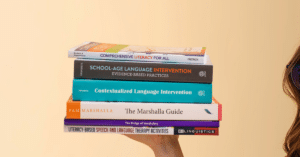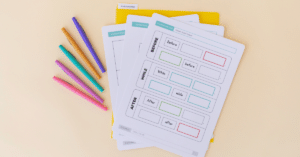Anyone else try reaaaallllly hard to keep your older students engaged? It’s not always an easy feat. Especially since some of them only want to play games, and anything curriculum-based makes them groan.
I’ve had a lot of success spending time on goal awareness and growth mindset, but technology is another huge winner with this population. Combine that with a literacy-based framework, and you have a recipe for success.
Engagement + Generalization = Happy SLPs and Students
The best part? It’s low prep! You can easily implement these ideas with your students tomorrow!
Let’s say “goodbye” to those yawns and groans!
I often use nonfiction reading passages with this population. The literacy-based therapy framework includes a “parallel story” at the end of the unit. This doesn’t always make sense in the context of a nonfiction text, so I’ve adapted it a bit to meet the needs of my students (and to better help them meet the demands of the curriculum).
Here are four of my favorite tools to use when working on generalization with literacy-based therapy…
1. Newscast
Students usually love this one! If they’re not feeling it, I might pull up a YouTube video of a funny newscast to get them inspired.
How does it work? We write a script summarizing the reading passage we just read. (This is a perfect way to combine all of the grammar, vocabulary, and other language skills that were targeted during the unit.) They then get to have fun and create their newscast! You can use any camera (or camera app). You don’t need anything fancy here!
They can share their final product with friends, teachers, and/or parents. At this point, they should be very familiar with the text and any repetition is a great way to continue practicing the target skills. Especially if it’s happening outside of the speech room!
2. Toontastic
Toontastic is a creative storytelling app. Students can use it to create a newscast for the article (using cartoon characters instead of recording their faces). It has some really great features (e.g., voice recording, music effects, the ability to share, and more)!
3. ChatterPix
Chatterpix is another tool that we can use to ramp up the engagement when retelling a story. You can take a picture of a key person in the text. Students can then record an audio clip retelling the story from that person’s point of view.
The best part? Students can replay the clip and see the person’s mouth moving. They will keep requesting replays, and they’ll get to hear their perfectly formulated summary (with key vocabulary and language concepts embedded). They won’t even know they’re learning!
4. Pictello
Pictello is another fun tool that students can use to create story boards. They can add pictures and audio for a nice final project that can easily be shared for generalization.
This is a paid app, but you could use Google Slides in a similar way.
Want to learn more?
I’ve got another post for you! This one is packed with even more engagement tools!
We are also starting a FREE literacy-based therapy challenge that will include free planning templates, materials, inspiration, and more! Click here to sign up!





Reader Interactions